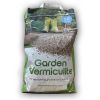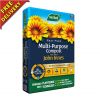Types of Soil
In this section I will explain Soil Types, help you determine what soil type you have and explain how you can improve on each. What makes one soil different from another is the components that make up soils. Or even better; the percentage of these components that make up a soil.
All soils are made up of 5 components, these are: sand, silt, clay, organic matter (and humus) and Minerals (nutrients). The percentage of each component determines the soils ability to drain, to hold water, to hold nutrients, maintain life, determine Acidity and maintain structure.
Most soils can be divided into the following groups:
- Sandy soils
- Clay soils
- Loam soils
- Peat soils
Sandy Soils
Basically these are soils with higher percentages of sand. Sand is a large soil particle that cannot be broken down any smaller, they are large, round grains and when they fit together they leave large ‘pore’ spaces or gaps between them. In soils, large pore spaces fill with air and not water. So, we can say that sandy soils have large gaps which hold air and allow water to flow down through them, providing for good soil drainage.
Sandy soils are:
- Full of large air holes.
- Free Draining soils
- Is easy to work with (light)
- Dries out quickly
- Minerals are easily leached.
- Lower in nutrients.
- Faster to warm up in spring
Clay Soils
Simply put, these are the opposite of sandy. Clay soils are soils with a high percentage of clay. Clay particles are small, flat and sticky particles. They are porous and fit tightly together; this means that in clay soils there are only small ‘pore’ spaces or gaps between the particles. Small poor spaces are better at holding water and not good at holding air. Therefore, we can say that clay soils hold a lot more water than they hold air.
Clays are also sticky and they help bind soils together to form larger soil clumps. Most soils in the midlands of Ireland are made up of 50% clay, 25% sand, 10% silt, 5% organic matter and 5% minerals (or nutrients). But some can be even higher in clay content.
Clay soils hold water and therefore hold nutrients so all highly fertile.
Clay soils are:
- Better at holding water
- Wetter and heavier soils
- Harder soils to work in wet conditions
- Naturally fertile soil.
- More fertile as leaching of minerals is slower
- Very poor drainage, which can lead to water logging.
- Is a cold soil
- Darker in colour
Silt Soils
Silt soils are soils with higher percentages of silt particles. Silt particles are basically smaller sand grains and therefore the pore spaces between the particles in smaller than that of sandy soils. Silts are common result of floodplains and are consider highly fertile. Also because they are smaller than sand and larger than clay they have a good balance of pore space sizes.
Silt soils are not a common soil type in Ireland
Silt soils are:
- Good at retaining water
- Slower draining than sandy soils
- Fertile soils
Loam soils
Loam soils are the perfect balance of each soil mentioned above. They have Intermediate characteristics of both clay and sandy soils, with more advantages and fewer disadvantages.
Loam soil composition is as follows; 40 % Sand, 30 % Silt and 20 % clay, 5% organic matter and 5% minerals (or nutrients).
While structure, drainage and workability of soil depends on its composition, the amount of organic matter is also a major factor, which influences fertility, worm content and acidity.
Peat soils
A peat soil is a soil which has a high percentage of Organic matter. Organic matter is partially decomposed plant and animal material that has been broken down over thousands of years. Organic matter is in high concentration in peat areas because peat bogs are damp and sufficient oxygen for decomposition to take place, this leads to a build up of organic material occurs.
While loam soils contain only 5% organic matter, peat soils can be over 50% organic matter.
Peats soils can be found in the midlands as well as around the west and North west of the country.
Peat soils are:
- High in organic matter
- Dark in colour
- Depth soils
- Higher fertility
- Poor draining
- Acidic soils













